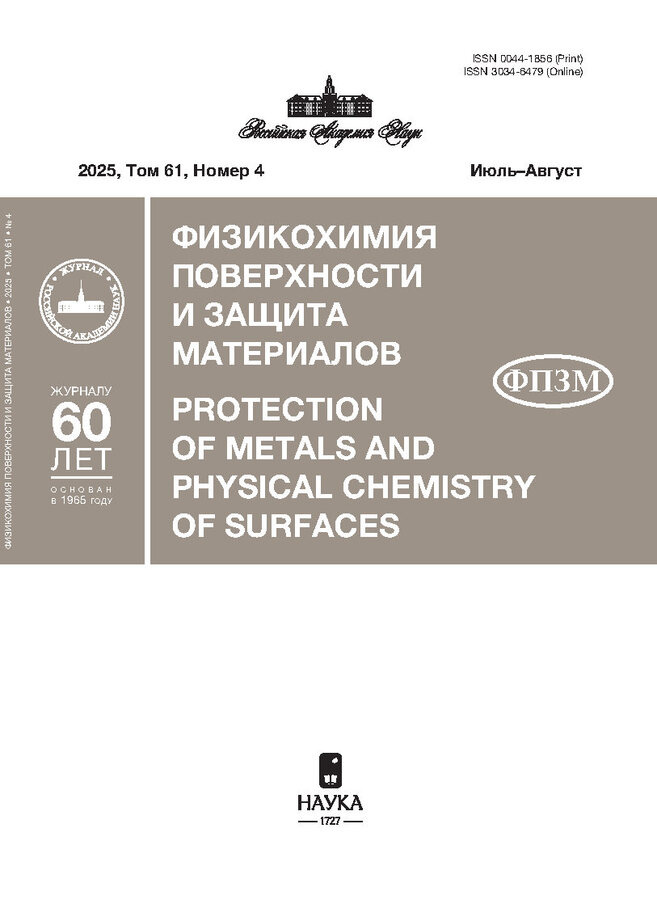Катализаторы восстановления кислорода на углеродном носителе Vulcan XC-72, модифицированном переходными металлами
- Авторы: Виноградов К.Ю.1, Шафигулин Р.В.1, Востриков С.В.2, Мартыненко Е.А.2, Подлипнов В.В.1, Буланова А.В.1
-
Учреждения:
- Самарский национальный исследовательский университет имени академика С.П. Королева
- Самарский государственный технический университет
- Выпуск: Том 59, № 6 (2023)
- Страницы: 577-585
- Раздел: ФИЗИКО-ХИМИЧЕСКИЕ ПРОЦЕССЫ НА МЕЖФАЗНЫХ ГРАНИЦАХ
- URL: https://journals.rcsi.science/0044-1856/article/view/233772
- DOI: https://doi.org/10.31857/S0044185623700729
- EDN: https://elibrary.ru/ABIIVP
- ID: 233772
Цитировать
Полный текст
Аннотация
В статье представлены результаты исследования каталитической активности биметаллических материалов, синтезированных на основе сажи Vulcan XC‑72, модифицированной никелем, кобальтом и молибденом, в реакции электрохимического восстановления кислорода. Исследования синтезированных катализаторов методом адсорбции-десорбции азота в вакууме показали, что они мезопористые, обладающие невысокими пористостью и площадью поверхности. После модифицирования металлами площадь поверхности катализатора и объем пор уменьшается. Спектры комбинационного рассеяния образцов свидетельствуют о вероятном образовании на поверхности катализаторов MoCo/C и NiMo/C интерметаллидов или смешанных оксидов молибдена, что согласуется с литературными данными. Сканирующая электронная микроскопия показала образование на аморфном Vulcan XC‑72 сферических частиц металлов. Все исследованные биметаллические катализаторы обладают схожими кинетическими характеристиками реакции электровосстановления кислорода, тем не менее катализаторы NiMo/C и NiNi/C проявили большую активность. Проверка стабильности работы синтезированных катализаторов показала их высокую коррозионную устойчивость.
Об авторах
К. Ю. Виноградов
Самарский национальный исследовательский университет имени академика С.П. Королева
Email: winyur@yandex.ru
Россия, 443086, Самара, ул. Московское шоссе, 34
Р. В. Шафигулин
Самарский национальный исследовательский университет имени академика С.П. Королева
Email: winyur@yandex.ru
Россия, 443086, Самара, ул. Московское шоссе, 34
С. В. Востриков
Самарский государственный технический университет
Email: winyur@yandex.ru
Россия, 443100, Самара, ул. Молодогвардейская, 244
Е. А. Мартыненко
Самарский государственный технический университет
Email: winyur@yandex.ru
Россия, 443100, Самара, ул. Молодогвардейская, 244
В. В. Подлипнов
Самарский национальный исследовательский университет имени академика С.П. Королева
Email: winyur@yandex.ru
Россия, 443086, Самара, ул. Московское шоссе, 34
А. В. Буланова
Самарский национальный исследовательский университет имени академика С.П. Королева
Автор, ответственный за переписку.
Email: winyur@yandex.ru
Россия, 443086, Самара, ул. Московское шоссе, 34
Список литературы
- Borup R.L. et al. // Current Opinion in Electrochemistry. 2020. V. 21. P. 192–200.
- Ott S. et al. // J. Electrochemical Society. 2022. V. 169. № 5. P. 054520.
- Wang L. et al. // J. Energy Chemistry. 2019. V. 39. P. 77–87.
- Muhyuddin M. et al. // J. Power Sources. 2023. V. 556. P. 232416.
- Liu M. et al. // Advanced Materials. 2019. V. 31. № 6. P. 1802234.
- Wu D. et al. // ChemNanoMat. 2020. V. 6. № 1. P. 32–41.
- Wu J., Yang H. // Accounts of chemical research. 2013. V. 46. № 8. P. 1848–1857.
- Shafigulin R.V. et al. // Reaction Kinetics, Mechanisms and Catalysis. 2021. V. 133. № 1. P. 455–465.
- Chen K. et al. // J. Colloid and Interface Science. 2021. V. 582. P. 977–990.
- Yoo D.J. et al. // New J. Chemistry. 2018. V. 42. № 17. P. 14386–14393.
- Samad S. et al. // International J. Hydrogen Energy. 2018. V. 43. № 16. P. 7823–7854.
- Wang C., Astruc D. // Progress in Materials Science. 2018. V. 94. P. 306–383.
- Sing K.S.W. // Pure and Applied Chemistry. 1985. V. 57. № 4. P. 603–619.
- Xiao T.C. et al. // J. Catalysis. 2001. V. 202. № 1. P. 100–109.
- Dufresne P. et al. // J. Physical Chemistry. 1981. V. 85. № 16. P. 2344–2351.
- Wu J. et al. // J. Power Sources. 2013. V. 227. P. 185–190.
- Martynenko E.A. et al. // J. Applied Electrochemistry. 2023. V. 53. № 4. P. 645–659.
- Bulanova A.V. et al. // Catalysts. 2022. V. 12. № 9. P. 1013.
Дополнительные файлы



















